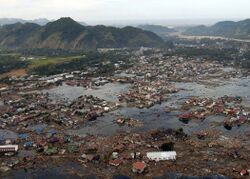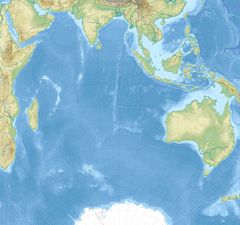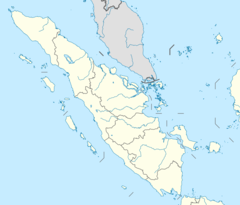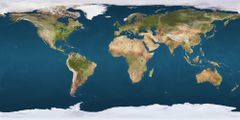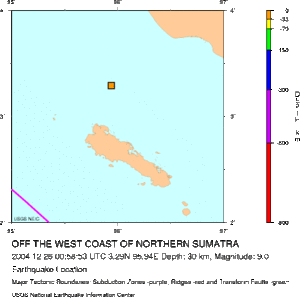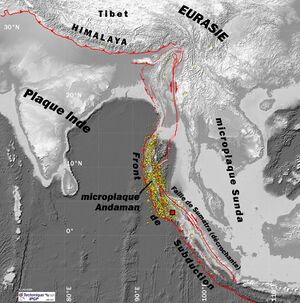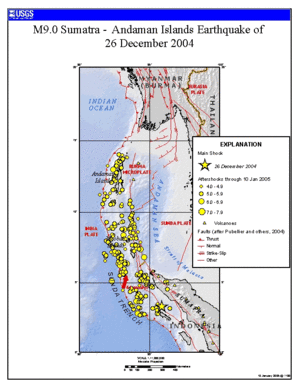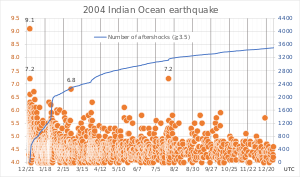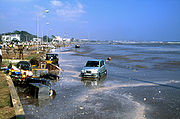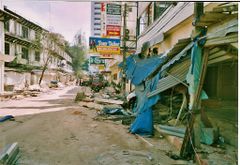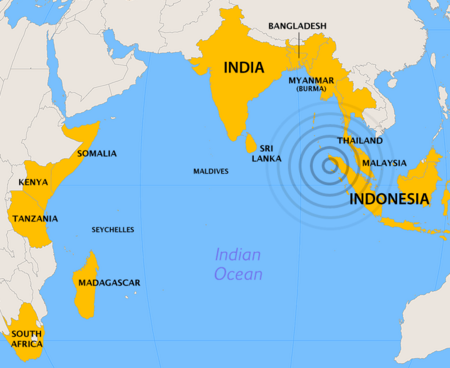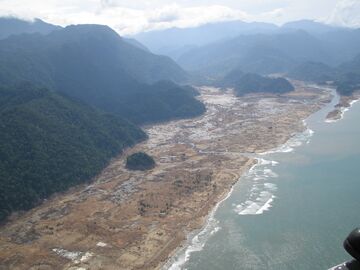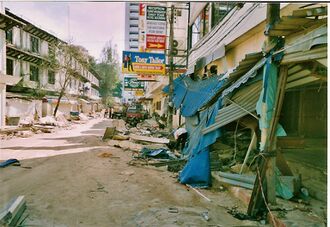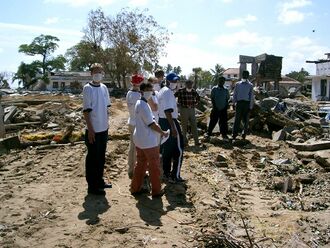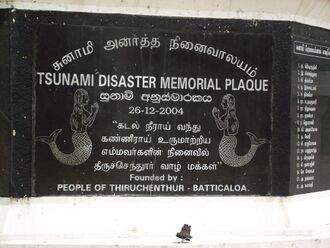زلزال وتسونامي المحيط الهندي 2004
| الوقت UTC | 2004-12-26 00:58:53 |
|---|---|
| حدث ISC | 7453151 |
| USGS-ANSS | ComCat |
| التاريخ المحلي | 26 ديسمبر 2004 |
| التوقيت المحلي | |
| المقدار | 9.1–9.3 Mw[2] |
| العمق | 30 km (19 mi)[1] |
| Epicentre | 3°18′58″N 95°51′14″E / 3.316°N 95.854°ECoordinates: 3°18′58″N 95°51′14″E / 3.316°N 95.854°E[1] |
| النوع | Megathrust |
| المناطق المتأثرة | Indian Ocean coastline areas |
| أقصى شدة | IX (عنيف) |
| التسونامي | |
| الخسائر | 227,898 dead[6][7][8] |
زلزال وتسونامي المحيط الهندي 2004، كان زلزال دفع هائل بحري وقع في الساعة 00:58:53 UTC يوم الأحد، 26 ديسمبر 2004، مركزه على السواحل الغربية المقابلة لسومطرة، إندونسيا. يعرف الزلزال في الأوساط العلمية باسم زلزال سومطرة–أندامان.[10][11] تسبب الزلال في حدوث تسونامي أطلق عليه أسماء مختلفة، وتشمل تسونامي المحيط الهندي 2004,، تسونامي جنوب شرق آسيا، التسونامي الإندونيسي، تسونامي الكريسماس وتسوناني يوم الملاكمة.[12]
حدث الزلزال عندما اندست الصفيحة الهندية تحت صفيحة بورما مما تسبب في إندلاج موجات تسونامي مدمرة على إمتداد سواحل معظم الكتل الأرضي المطلة على المحيط الهندي، مما أدى لمقتل 230.000 شخص في البلدان الأربعة عشر، وغرق التجمعات الساحلية بموجات وصل إرتفاعها إلى أكثر من 30 متر.[4] وكان واحد من أكثر الكوارث الطبيعية المسجلة في التاريخ فتكاً. كانت إندونسيا هي أكثر البلدان المتضررة، بعدها سريلانكا، الهند، وتايلاند.
بقوة مقدارها 9.1-3.0 درجة، كان الزلزال ثالث أكبر زلزال تم تسجيله على مخطط الزلازل. الزلزال كان الأطول زمناً، حيث استمر ما بين 8.3 و10 دقائق. وتسببر في إهتزاز في الكوكب بأسره بمقدار 1 centimetre (0.4 inches)[13] وأدى لوقوع زلازال أخرى على في أماكن بعيدة مثل ألاسكا.[14] مركز الزلزال كن بين جزيرة سيميوليو والبر الرئيسي لإندونسيا.[15] حصلت البلدان المتأثرة بالكارثة تلقت مساعدات إنسانية من جميع أنحاء العالم. تبرع المجتمع العالمي بمساعدات إنسانية وصلت قيمتها لأكثر من 14 بليون دولار.[16]
It was the most powerful earthquake ever recorded in Asia, the most powerful earthquake in the 21st century, and at least the third most powerful earthquake ever recorded in the world since modern seismography began in 1900. It had the longest duration of faulting ever observed, between eight and ten minutes.[17] It caused the planet to vibrate as much as 10 mm (0.4 in),[18] and also remotely triggered earthquakes as far away as Alaska.[19] Its epicentre was between Simeulue and mainland Sumatra.[15] The plight of the affected people and countries prompted a worldwide humanitarian response, with donations totalling more than US$14 billion[20] (equivalent to US$Error when using {{Inflation}}: |index=USD (parameter 1) not a recognized index. billion in 2022 currency).
. . . . . . . . . . . . . . . . . . . . . . . . . . . . . . . . . . . . . . . . . . . . . . . . . . . . . . . . . . . . . . . . . . . . . . . . . . . . . . . . . . . . . . . . . . . . . . . . . . . . . . . . . . . . . . . . . . . . . . . . . . . . . . . . . . . . . . . . . . . . . . . . . . . . . . . . . . . . . . . . . . . . . . . .
الزلزال
قالب:2004 Indian Ocean earthquake and tsunami
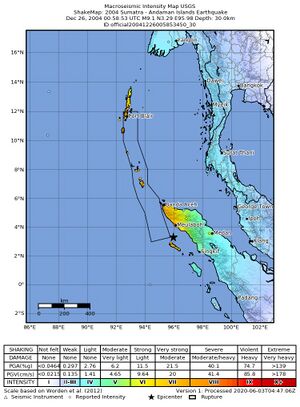
The 2004 Indian Ocean earthquake was initially documented as having a moment magnitude of 8.8. In February 2005, scientists revised the estimate of the magnitude to 9.0.[21] Although the Pacific Tsunami Warning Center has accepted these new numbers, the United States Geological Survey has, as of 2022, so far not changed its estimate of 9.1.[22] A 2006 study estimated a magnitude of Mw 9.1–9.3; Hiroo Kanamori of the California Institute of Technology estimates that Mw 9.2 is representative of the earthquake's size.[23]
The hypocentre of the main earthquake was approximately 160 km (100 mi) off the western coast of northern Sumatra, in the Indian Ocean just north of Simeulue island at a depth of 30 km (19 mi) below mean sea level (initially reported as 10 km or 6.2 mi). The northern section of the Sunda megathrust ruptured over a length of 1,300 km (810 mi).[15] The earthquake (followed by the tsunami) was felt in Bangladesh, India, Malaysia, Myanmar, Thailand, Sri Lanka and the Maldives.[24] Splay faults, or secondary "pop up faults", caused long, narrow parts of the seafloor to pop up in seconds. This quickly elevated the height and increased the speed of waves, destroying the nearby Indonesian town of Lhoknga.[25]
Indonesia lies between the Pacific Ring of Fire along the north-eastern islands adjacent to New Guinea, and the Alpide belt that runs along the south and west from Sumatra, Java, Bali, Flores to Timor. The 2002 Sumatra earthquake is believed to have been a foreshock, preceding the main event by over two years.[26]
Historical comparisons
Great earthquakes, such as the 2004 Indian Ocean earthquake, are associated with megathrust events in subduction zones. Their seismic moments can account for a significant fraction of the global seismic moment across century-scale periods. Of all the moment released by earthquakes in the 100 years from 1906 through 2005, roughly one eighth was due to the 2004 Indian Ocean earthquake.[27] This quake, together with the Great Alaskan earthquake (1964) and the Great Chilean earthquake (1960), account for almost half of the total moment.[27][28]
Since 1900, the only earthquakes recorded with a greater magnitude were the 1960 Valdivia earthquake (magnitude 9.5) and the 1964 Alaska earthquake in Prince William Sound (magnitude 9.2). The only other recorded earthquakes of magnitude 9.0 or greater were off Kamchatka, Russia, on 5 November 1952 (magnitude 9.0) and Tōhoku, Japan (magnitude 9.1) in March 2011. Each of these megathrust earthquakes also spawned tsunamis in the Pacific Ocean. In comparison to the 2004 Indian Ocean earthquake, the death toll from these earthquakes and tsunamis was significantly lower, primarily because of the lower population density along the coasts near affected areas.[29]
Comparisons with earlier earthquakes are difficult, as earthquake strength were not measured systematically until the 1930s.[30] However, historical earthquake strength can sometimes be estimated by examining historical descriptions of the damage caused, and the geological records of the areas where they occurred.[31] Some examples of significant historical megathrust earthquakes are the 1868 Arica earthquake in Peru and the 1700 Cascadia earthquake in western North America.
الصفائح التكتونية
The 2004 Indian Ocean earthquake was unusually large in geographical and geological extent. An estimated 1,600 km (1,000 mi) of fault surface slipped (or ruptured) about 15 m (50 ft) along the subduction zone where the Indian Plate slides under (or subducts) the overriding Burma Plate. The slip did not happen instantaneously but took place in two phases over several minutes: Seismographic and acoustic data indicate that the first phase involved a rupture about 400 km (250 mi) long and 100 km (60 mi) wide, 30 km (19 mi) beneath the sea bed—the largest rupture ever known to have been caused by an earthquake. The rupture proceeded at about 2.8 km/s (1.74 mi/s; 10,100 km/h; 6,260 mph), beginning off the coast of Aceh and proceeding north-westerly over about 100 seconds. After a pause of about another 100 seconds, the rupture continued northwards towards the Andaman and Nicobar Islands. The northern rupture occurred more slowly than in the south, at about 2.1 km/s (1.3 mi/s; 7,600 km/h; 4,700 mph), continuing north for another five minutes to a plate boundary where the fault type changes from subduction to strike-slip (the two plates slide past one another in opposite directions).
The Indian Plate is part of the great Indo-Australian Plate, which underlies the Indian Ocean and Bay of Bengal, and is moving north-east at an average of 60 mm/a (0.075 in/Ms). The India Plate meets the Burma Plate (which is considered a portion of the great Eurasian Plate) at the Sunda Trench. At this point, the India Plate subducts beneath the Burma Plate, which carries the Nicobar Islands, the Andaman Islands, and northern Sumatra. The India Plate sinks deeper and deeper beneath the Burma Plate until the increasing temperature and pressure drive volatiles out of the subducting plate. These volatiles rise into the overlying plate, causing partial melting and the formation of magma. The rising magma intrudes into the crust above and exits the Earth's crust through volcanoes in the form of a volcanic arc. The volcanic activity that results as the Indo-Australian Plate subducts the Eurasian Plate has created the Sunda Arc.
As well as the sideways movement between the plates, the 2004 Indian Ocean earthquake resulted in a rise of the seafloor by several metres, displacing an estimated 30 km3 (7.2 cu mi) of water and triggering devastating tsunami waves. The waves radiated outwards along the entire 1,600 km (1,000 mi) length of the rupture (acting as a line source). This greatly increased the geographical area over which the waves were observed, reaching as far as Mexico, Chile, and the Arctic. The raising of the seafloor significantly reduced the capacity of the Indian Ocean, producing a permanent rise in the global sea level by an estimated 0.1 mm (0.004 in).[32]
التوابع وزلازل أخرى
Numerous aftershocks were reported off the Andaman Islands, the Nicobar Islands and the region of the original epicentre in the hours and days that followed. The magnitude 8.7 2005 Nias–Simeulue earthquake, which originated off the coast of the Sumatran island of Nias, is not considered an aftershock, despite its proximity to the epicentre, and was most likely triggered by stress changes associated with the 2004 event.[33] The earthquake produced its own aftershocks (some registering a magnitude of as high as 6.9[34]) and presently ranks as the third-largest earthquake ever recorded on the moment magnitude or Richter magnitude scale.
Other aftershocks of up to magnitude 7.2[35] continued to shake the region daily for three or four months.[36] As well as continuing aftershocks, the energy released by the original earthquake continued to make its presence felt well after the event. A week after the earthquake, its reverberations could still be measured, providing valuable scientific data about the Earth's interior.
The 2004 Indian Ocean earthquake came just three days after a magnitude 8.1 earthquake in the sub-antarctic Auckland Islands, an uninhabited region west of New Zealand, and Macquarie Island to Australia's north. This is unusual since earthquakes of magnitude eight or more occur only about once per year on average.[37] The U.S. Geological Survey sees no evidence of a causal relationship between these events.[38]
The 2004 Indian Ocean earthquake is thought to have triggered activity in both Leuser Mountain[39] and Mount Talang,[40] volcanoes in Aceh along the same range of peaks, while the 2005 Nias–Simeulue earthquake sparked activity in Lake Toba, a massive caldera in Sumatra.[41]
الطاقة المنطلقة
The energy released on the Earth's surface (ME, which is the seismic potential for damage) by the 2004 Indian Ocean earthquake was estimated at 1.1×1017 joules (110 PJ; 26 Mt).[42] This energy is equivalent to over 1,500 times that of the Hiroshima atomic bomb, but less than that of Tsar Bomba, the largest nuclear weapon ever detonated.[43]
The earthquake generated a seismic oscillation of the Earth's surface of up to 200–300 mm (8–12 in), equivalent to the effect of the tidal forces caused by the Sun and Moon. The seismic waves of the earthquake were felt across the planet, as far away as the U.S. state of Oklahoma, where vertical movements of 3 mm (0.12 in) were recorded. By February 2005, the earthquake's effects were still detectable as a 20 μm (0.02 mm; 0.0008 in) complex harmonic oscillation of the Earth's surface, which gradually diminished and merged with the incessant free oscillation of the Earth more than four months after the earthquake.[44]
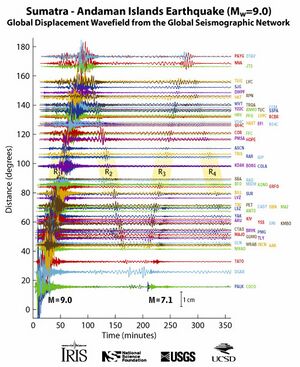
Because of its enormous energy release and shallow rupture depth, the earthquake generated remarkable seismic ground motions around the globe, particularly due to huge Rayleigh (surface) elastic waves that exceeded 10 mm (0.4 in) in vertical amplitude everywhere on Earth. The record section plot displays vertical displacements of the Earth's surface recorded by seismometers from the IRIS/USGS Global Seismographic Network plotted with respect to time (since the earthquake initiation) on the horizontal axis, and vertical displacements of the Earth on the vertical axis (note the 1 cm scale bar at the bottom for scale). The seismograms are arranged vertically by distance from the epicentre in degrees. The earliest, lower amplitude signal is that of the compressional (P) wave, which takes about 22 minutes to reach the other side of the planet (the antipode; in this case near Ecuador). The largest amplitude signals are seismic surface waves that reach the antipode after about 100 minutes. The surface waves can be clearly seen to reinforce near the antipode (with the closest seismic stations in Ecuador), and to subsequently encircle the planet to return to the epicentral region after about 200 minutes. A major aftershock (magnitude 7.1) can be seen at the closest stations starting just after the 200-minute mark. The aftershock would be considered a major earthquake under ordinary circumstances but is dwarfed by the mainshock.
The shift of mass and the massive release of energy slightly altered the Earth's rotation. Weeks after the earthquake, theoretical models suggested the earthquake shortened the length of a day by 2.68 microseconds, due to a decrease in the oblateness of the Earth. [45] It also caused the Earth to minutely "wobble" on its axis by up to 25 mm (1 in) in the direction of 145° east longitude,[46] or perhaps by up to 50 or 60 mm (2.0 or 2.4 in).[47] Because of tidal effects of the Moon, the length of a day increases at an average of 15 microseconds per year, so any rotational change due to the earthquake will be lost quickly. Similarly, the natural Chandler wobble of the Earth, which in some cases can be up to 15 m (50 ft), eventually offset the minor wobble produced by the earthquake.
There was 10 m (33 ft) movement laterally and 4–5 m (13–16 ft) vertically along the fault line. Early speculation was that some of the smaller islands south-west of Sumatra, which is on the Burma Plate (the southern regions are on the Sunda Plate), might have moved south-west by up to 36 m (120 ft), but more accurate data released more than a month after the earthquake found the movement to be about 0.2 m (8 in).[48] Since movement was vertical as well as lateral, some coastal areas may have been moved to below sea level. The Andaman and Nicobar Islands appear to have shifted south-west by around 1.25 m (4 ft 1 in) and to have sunk by 1 m (3 ft 3 in).[49]
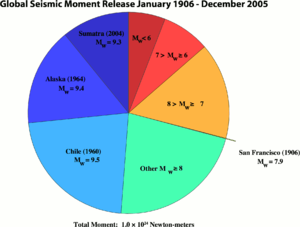
In February 2005, the Royal Navy vessel إتشإمإس Scott surveyed the seabed around the earthquake zone, which varies in depth between 1,000 and 5,000 m (550 and 2,730 fathoms; 3,300 and 16,400 ft). The survey, conducted using a high-resolution, multi-beam sonar system, revealed that the earthquake had made a considerable impact on the topography of the seabed. 1,500-metre-high (5,000 ft) thrust ridges created by previous geologic activity along the fault had collapsed, generating landslides several kilometres wide. One such landslide consisted of a single block of rock some 100 m (330 ft) high and 2 km (1.2 mi) long. The momentum of the water displaced by tectonic uplift had also dragged massive slabs of rock, each weighing millions of tonnes, as far as 10 km (6 mi) across the seabed. An oceanic trench several kilometres wide was exposed in the earthquake zone.[50]
The TOPEX/Poseidon and Jason-1 satellites happened to pass over the tsunami as it was crossing the ocean.[51] These satellites carry radars that measure precisely the height of the water surface; anomalies in the order of 500 mm (20 in) were measured. Measurements from these satellites may prove invaluable for the understanding of the earthquake and tsunami.[52] Unlike data from tide gauges installed on shores, measurements obtained in the middle of the ocean can be used for computing the parameters of the source earthquake without having to compensate for the complex ways in which proximity to the coast changes the size and shape of a wave.
. . . . . . . . . . . . . . . . . . . . . . . . . . . . . . . . . . . . . . . . . . . . . . . . . . . . . . . . . . . . . . . . . . . . . . . . . . . . . . . . . . . . . . . . . . . . . . . . . . . . . . . . . . . . . . . . . . . . . . . . . . . . . . . . . . . . . . . . . . . . . . . . . . . . . . . . . . . . . . . . . . . . . . . .
التسونامي
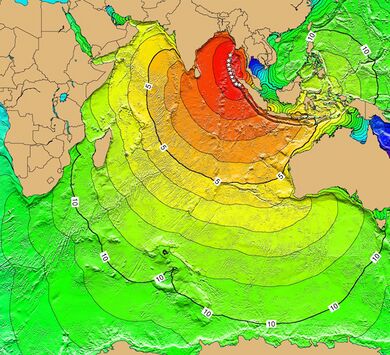
The sudden vertical rise of the seabed by several metres during the earthquake displaced massive volumes of water, resulting in a tsunami that struck the coasts of the Indian Ocean. A tsunami that causes damage far away from its source is sometimes called a teletsunami and is much more likely to be produced by the vertical motion of the seabed than by horizontal motion.[53]
The tsunami, like all others, behaved differently in deep water than in shallow water. In deep ocean water, tsunami waves form only a low, broad hump, barely noticeable and harmless, which generally travels at high speed of 500 to 1,000 km/h (310 to 620 mph); in shallow water near coastlines, a tsunami slows down to only tens of kilometres per hour but, in doing so, forms large destructive waves. Scientists investigating the damage in Aceh found evidence that the wave reached a height of 24 m (80 ft) when coming ashore along large stretches of the coastline, rising to 30 m (100 ft) in some areas when travelling inland.[4] Radar satellites recorded the heights of tsunami waves in deep water: maximum height was at 600 mm (2 ft) two hours after the earthquake, the first such observations ever made.[54][55]
According to Tad Murty, vice-president of the Tsunami Society, the total energy of the tsunami waves was equivalent to about 5 megatons of TNT (21 PJ), which is more than twice the total explosive energy used during all of World War II (including the two atomic bombs) but still a couple of orders of magnitude less than the energy released in the earthquake itself. In many places, the waves reached as far as 2 km (1.2 mi) inland.[56]
Because the 1,600 km (1,000 mi) fault affected by the earthquake was in a nearly north–south orientation, the greatest strength of the tsunami waves was in an east–west direction. Bangladesh, which lies at the northern end of the Bay of Bengal, had few casualties despite being a low-lying country relatively near the epicentre. It also benefited from the fact that the earthquake proceeded more slowly in the northern rupture zone, greatly reducing the energy of the water displacements in that region.
Coasts that have a landmass between them and the tsunami's location of origin are usually safe; however, tsunami waves can sometimes diffract around such landmasses. Thus, the state of Kerala was hit by the tsunami despite being on the western coast of India, and the western coast of Sri Lanka suffered substantial impacts. Distance alone was no guarantee of safety, as Somalia was hit harder than Bangladesh despite being much farther away.
Because of the distances involved, the tsunami took anywhere from fifteen minutes to seven hours to reach the coastlines.[57][58] The northern regions of the Indonesian island of Sumatra were hit quickly, while Sri Lanka and the east coast of India were hit roughly 90 minutes to two hours later. Thailand was struck about two hours later despite being closer to the epicentre because the tsunami travelled more slowly in the shallow Andaman Sea off its western coast.
The tsunami was noticed as far as Struisbaai in South Africa, about 8,500 km (5,300 mi) away, where a 1.5-metre-high (5 ft) tide surged on shore about 16 hours after the earthquake. It took a relatively long time to reach Struisbaai at the southernmost point of Africa, probably because of the broad continental shelf off South Africa and because the tsunami would have followed the South African coast from east to west. The tsunami also reached Antarctica, where tidal gauges at Japan's Showa Base recorded oscillations of up to a metre (3 ft 3 in), with disturbances lasting a couple of days.[59]
Some of the tsunami's energy escaped into the Pacific Ocean, where it produced small but measurable tsunamis along the western coasts of North and South America, typically around 200 to 400 mm (7.9 to 15.7 in).[60] At Manzanillo, Mexico, a 2.6 m (8.5 ft) crest-to-trough tsunami was measured. As well, the tsunami was large enough to be detected in Vancouver, which puzzled many scientists, as the tsunamis measured in some parts of South America were larger than those measured in some parts of the Indian Ocean. It has been theorized that the tsunamis were focused and directed at long ranges by the mid-ocean ridges which run along the margins of the continental plates.[61]
العلامات والإنذارات المبكرة
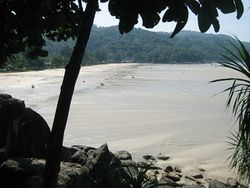
تفتقر دول المحيط الهندي إلى أجهزة إنذار مبكر لموجات تسونامي حال حدوثها ليتسنى لتلك الدول لعمل الترتيبات اللازمة لمواطنيها الذين يقطنون المناطق الساحلية خلافا للدول الواقعة على المحيط الهادي والاطلسي، ويذكر أن مركز رصد الزلازل الأمريكي رصد الصدع الأرضي في قاع المحيط الهندي لحظة حدوثة وقام بإبلاغ أستراليا بعد ساعة من حدوث الصدع التي بدورها أعلمت اندونيسيا بعد فوات الأوان.
وتجدر الإشارة ان اجهزة الرصد المبكر لموجات المد الناجمة عن الصدوع الأرضية في قاع المحيط رخيصة التكلفة والتطبيق إذا ما قورنت بكمية الخسائر البشرية التي أحدثتها موجة المد في المحيط الهندي.
الخسائر والضحايا
حسب التقديرات الأولية فأن أكثر من 160.000 قد فقدوا حياتهم نتيجة موجة المد، وعشرات الآف من الناس مفقودين وأكثر من مليون شخص بلا مأوى، كما أن ثلث الموتى من الأطفال، وتقريبا أكثر من 5000 من السياح الاجانب الذين ارادوا تمضية اعياد السنة الميلادية.
| بلدان سقط فيها قتلى |
مؤكدة | تقديرات1 | مصابون | مفقودون | مشردون |
|---|---|---|---|---|---|
| إندونسيا | 130,736 | 167,799 | n/a | 37,063 | 500,000+[62] |
| سيرلانكا2 | 35,322[63] | 35,322 | 21,411[63] | n/a | 516,150[63] |
| الهند | 12,405 | 18,045 | n/a | 5,640 | 647,599 |
| تايلاند | 5,3953[64] | 8,212 | 8,457[65] | 2,817[64] | 7,000 |
| الصومال | 78 | 289[66] | n/a | n/a | 5,000[67] |
| ميانمار | 61 | 400–600[68] | 45 | 200[69] | 3,200 |
| المالديڤ | 82[70] | 108[71] | n/a | 26 | 15,000+ |
| ماليزيا | 68[72] | 75 | 299[73] | 6 | n/a |
| تنزانيا | 10[74] | 13 | n/a | n/a | n/a |
| سيشل | 3[75] | 3 | 57[75] | n/a | 200[76] |
| بنگلادش | 2 | 2 | n/a | n/a | n/a |
| جنوب أفريقيا | 24[77] | 2 | n/a | n/a | n/a |
| اليمن | 2[78] | 2 | n/a | n/a | n/a |
| كنيا | 1 | 1 | 2 | n/a | n/a |
| مدغشقر | n/a | n/a | n/a | n/a | 1,000+[79] |
| الإجمالي | ~184,167 | ~230,273 | ~125,000 | ~45,752 | ~1.69 million |
ملاحظة: جميع الأرقام تقريبية وقابلة للتغيير. العمود الأول مرتبط بتفاصيل مزيدة عن بلدان محددة.
1 تشمل المبلغ عنه تحت اسم 'غير مؤكد'. في حالة عدم وجود تقديرات منفصلة، الرقم الموجود في هذا العمود هو نفسه الذي أبلغ عنه كغير مؤكد'.
2 لا يشمل حوالي 19,000 الذين فقدوا في البداية وأبلغت عنها سلطات نمور التاميل في المناطق الواقعت تحت سيطرتهم.
3 البيانات تشمل 2,464 أجنبي على الأقل.
4 لا يشمل الجنوب أفارقة المتوفون خارج جنوب أفريقيا (مثل السياح في تايلاند). لمزيد من المعلوما عن هذه الوفيات، انظر هنا
. . . . . . . . . . . . . . . . . . . . . . . . . . . . . . . . . . . . . . . . . . . . . . . . . . . . . . . . . . . . . . . . . . . . . . . . . . . . . . . . . . . . . . . . . . . . . . . . . . . . . . . . . . . . . . . . . . . . . . . . . . . . . . . . . . . . . . . . . . . . . . . . . . . . . . . . . . . . . . . . . . . . . . . .
Impact
Countries affected
According to the U.S. Geological Survey, a total of 227,898 people died.[1] Measured in lives lost, this is one of the ten worst earthquakes in recorded history, as well as the single worst tsunami in history. Indonesia was the worst affected area, with most death toll estimates at around 170,000.[80] An initial report by Siti Fadilah Supari, the Indonesian Minister of Health at the time, estimated the death total to be as high as 220,000 in Indonesia alone, giving a total of 280,000 fatalities.[81] However, the estimated number of dead and missing in Indonesia were later reduced by over 50,000. In their report, the Tsunami Evaluation Coalition stated, "It should be remembered that all such data are subject to error, as data on missing persons especially are not always as good as one might wish".[6] A much higher number of deaths has been suggested for Myanmar based on reports from Thailand.[68]
The tsunami caused severe damage and deaths as far as the east coast of Africa, with the furthest recorded fatality directly attributed to the tsunami at Rooi-Els, close to Cape Town, 8,000 km (5,000 mi) from the epicentre.[82]
Relief agencies reported that one third of the dead appeared to be children. This was a result of the high proportion of children in the populations of many of the affected regions and because children were the least able to resist being overcome by the surging waters. Oxfam went on to report that as many as four times more women than men were killed in some regions because they were waiting on the beach for the fishers to return and looking after their children in the houses.[83]
States of emergency were declared in Sri Lanka, Indonesia, and the Maldives. The United Nations estimated at the outset that the relief operation would be the costliest in human history.[بحاجة لمصدر] Then-UN Secretary-General Kofi Annan stated that reconstruction would probably take between five and ten years. Governments and non-governmental organizations feared that the final death toll might double as a result of diseases, prompting a massive humanitarian response.[بحاجة لمصدر]
In addition to a large number of local residents, up to 9,000 foreign tourists (mostly Europeans) enjoying the peak holiday travel season were among the dead or missing, especially people from the Nordic countries.[84] Sweden was the European country most severely affected both in absolute numbers, and by a wide margin when considered in relation to the country's population, with a death toll of 543. Germany was close behind with 539 identified victims.
| Affected country[a] | Confirmed deaths | Estimated deaths[b] | Injured | Missing | Displaced | Ref |
|---|---|---|---|---|---|---|
| 130,736 | 167,540 | 37,063 | 500,000+ | [62] | ||
| 35,322[c] | 35,322 | 21,411 | 516,150 | [63] | ||
| 12,405 | 16,269 | 3,874 | 647,599 | |||
| 5,395[d] | 8,212 | 8,457 | 2,817 | 7,000 | [64][65] | |
| 78 | 289 | 5,000 | [85][86] | |||
| 61 | 400–600 | 45 | 200 | 3,200 | [68][87] | |
| 82 | 108 | 26 | 15,000+ | [88][71] | ||
| 68 | 75 | 299 | 6 | 5٬000+ | [89][90] | |
| 10 | 13 | 3 | [91] | |||
| 3 | 3 | 57 | 200 | [75][92] | ||
| 2 | 2 | [93] | ||||
| 2[e] | 2 | [77] | ||||
| 2 | 2 | [94] | ||||
| 1 | 1 | 2 | ||||
| 1,000+ | [95] | |||||
| Total estimates | 184,167 | 227,898 | 125,000 | 43,789 | 1,740,000 | |
| ||||||
Environmental impact
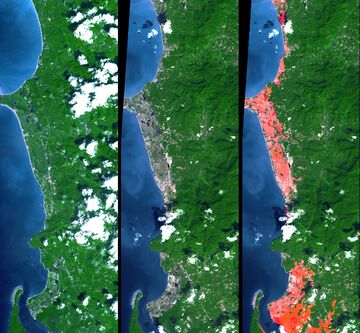
Beyond the heavy toll on human lives, the Indian Ocean earthquake caused an enormous environmental impact that affected the region for many years. Severe damage was inflicted on ecosystems such as mangroves, coral reefs, forests, coastal wetlands, vegetation, sand dunes and rock formations, animal and plant biodiversity and groundwater. Also, the spread of solid and liquid waste and industrial chemicals, water pollution and the destruction of sewage collectors and treatment plants threatened the environment even further, in untold ways. The environmental impact took a long time and significant resources to assess.[96]
The main effect was caused by poisoning of the freshwater supplies and of the soil by saltwater infiltration and a deposit of a salt layer over arable land. In the Maldives, 16 to 17 coral reef atolls that were overcome by sea waves are without fresh water and could be rendered uninhabitable for decades. Uncountable wells that served communities were invaded by sea, sand, and earth; and aquifers were invaded through porous rock. On the island's east coast, the tsunami contaminated wells on which many villagers relied for drinking water.[97]
The Colombo-based International Water Management Institute monitored the effects of saltwater and concluded that the wells recovered to pre-tsunami drinking water quality one-and-a-half years after the event.[97] The IWMI developed protocols for cleaning wells contaminated by saltwater; these were subsequently officially endorsed by the World Health Organization as part of its series of Emergency Guidelines.[98]
Salted-over soil becomes sterile, and it is difficult and costly to restore for agriculture. It also causes the death of plants and important soil micro-organisms. Thousands of rice, mango, and banana plantations in Sri Lanka were destroyed almost entirely and will take years to recover.[97]
In addition to other forms of aid,[99] the Australian government sent ecological experts to help develop strategies for reef-monitoring and rehabilitation of marine environments and coral reefs in the Maldives, Seychelles and other areas. Scientists had developed significant ecological expertise from work with the Great Barrier Reef, in Australia's northeastern waters.[100]
In response to the unprecedented situation, the United Nations Environment Programme (UNEP) worked with governments in the region to determine the severity of the ecological impact and how to address it.[101] UNEP established an emergency fund, set up a Task Force to respond to requests for assistance from countries affected by the tsunami, and was able to mobilize and distribute approximately US$9.3 million for environmental recovery and disaster risk reduction between 2004 and 2007. Funding came from other international agencies and from countries including Finland, Norway, Spain, Sweden and the United Kingdom.[102][103]
Evidence suggested that the presence of mangroves in coastal areas had provided some protection, when compared to areas that had been cleared for aquaculture or development. As a result, mangrove restoration become a focus of a number of projects, with varied success. Such approaches to ecosystem-based disaster risk reduction appear to be most successful when local communities are closely involved as stakeholders throughout the process, and when careful attention is paid to the physical conditions of chosen sites to ensure that mangroves can thrive there.[104]
Economic impact
The level of damage to the economy resulting from the tsunami depends on the scale examined. While the overall impact on the national economies was minor, local economies were devastated. The two main occupations affected by the tsunami were fishing and tourism.[105] Some economists believe that damage to the affected national economies will be minor because losses in the tourism and fishing industries are a relatively small percentage of the GDP. However, others caution that damage to infrastructure is an overriding factor. In some areas drinking water supplies and farm fields may have been contaminated for years by saltwater from the ocean.[106]
The impact on coastal fishing communities and the people living there, some of the poorest in the region, has been devastating with high losses of income earners as well as boats and fishing gear.[107][108] In Sri Lanka, artisanal fishery, in which the use of fish baskets, fishing traps, and spears are commonly used, is an important source of fish for local markets; industrial fishery is the major economic activity, providing direct employment to about 250,000 people. In recent years the fishery industry has emerged as a dynamic export-oriented sector, generating substantial foreign exchange earnings. Preliminary estimates indicated that 66% of the fishing fleet and industrial infrastructure in coastal regions were destroyed by the wave surges.[109]
While the tsunami destroyed many of the boats vital to Sri Lanka's fishing industry, it also created a demand for fibreglass-reinforced plastic catamarans in the boatyards of Tamil Nadu. Given that over 51,000 vessels were lost to the tsunami, the industry boomed. However, the huge demand has led to lower quality in the process, and some important materials were sacrificed to cut prices for those who were impoverished by the tsunami.[110]
Even though only coastal regions were directly affected by the waters of the tsunami, the indirect effects have spread to inland provinces as well. Since the media coverage of the event was so extensive, many tourists cancelled vacations and trips to that part of the world, even though their travel destinations may not have been affected. This ripple effect could especially be felt in the inland provinces of Thailand, such as Krabi, which acted as a starting point for many other tourist destinations in Thailand.[111]
Countries in the region appealed to tourists to return, pointing out that most tourist infrastructure is undamaged. However, tourists were reluctant to do so for psychological reasons. Even beach resorts in parts of Thailand which were untouched by the tsunami were hit by cancellations.[112]
Both the earthquake and the tsunami may have affected shipping in the Malacca Straits, which separate Malaysia and the Indonesian island of Sumatra, by changing the depth of the seabed and by disturbing navigational buoys and old shipwrecks. In one area of the Strait, water depths were previously up to 1,200 m (4,000 ft), and are now only 30 m (100 ft) in some areas, making shipping impossible and dangerous. These problems also made the delivery of relief aid more challenging. Compiling new navigational charts may take months or years. Officials also hoped that piracy in the region would drop off, since the tsunami had killed pirates and destroyed their boats.[113] Due to multiple factors, there was a 71.6% drop in the number of piracy incidents between 2004 and 2005, from 60 to 17 incidents. Levels remained relatively low for some years. However, between 2013 and 2014, piracy incidents rose dramatically by 73.2% to exceed pre-tsunami levels.[114]
Historical context
The last major tsunami in the Indian Ocean was about A.D. 1400.[115][116] In 2008, a team of scientists working on Phra Thong, a barrier island along the hard-hit west coast of Thailand, reported evidence of at least three previous major tsunamis in the preceding 2,800 years, the most recent from about 700 years ago. A second team found similar evidence of previous tsunamis in Aceh, a province at the northern tip of Sumatra; radiocarbon dating of bark fragments in the soil below the second sand layer led the scientists to estimate that the most recent predecessor to the 2004 tsunami probably occurred between A.D. 1300 and 1450.[117]
The 2004 earthquake and tsunami combined is the world's deadliest natural disaster since the 1976 Tangshan earthquake. The earthquake was the third-most-powerful earthquake recorded since 1900. The deadliest-known earthquake in history occurred in 1556 in Shaanxi, China, with an estimated death toll of 830,000, though figures from this period may not be as reliable.[118]
Before 2004, the tsunami created in both Indian and Pacific Ocean waters by the 1883 eruption of Krakatoa, thought to have resulted in anywhere from 36,000 to 120,000 deaths, had probably been the deadliest in the region. In 1782, about 40,000 people are thought to have been killed by a tsunami (or a cyclone) in the South China Sea.[119] The deadliest tsunami before 2004 was Italy's 1908 Messina earthquake on the Mediterranean Sea where the earthquake and tsunami killed about 123,000.[120]
Other effects
Many health professionals and aid workers have reported widespread psychological trauma associated with the tsunami.[121] Even 14 years afterwards, researchers find HPA axis dysregulation and “burnout” in survivors.[122] Traditional beliefs in many of the affected regions state that a relative of the family must bury the body of the dead, and in many cases, no body remained to be buried. Women in Aceh required a special approach from foreign aid agencies, and continue to have unique needs.[بحاجة لمصدر]
The hardest-hit area, Aceh, is a religiously conservative Islamic society and has had no tourism nor any Western presence in recent years due to the insurgency between the Indonesian military and Free Aceh Movement (GAM). Some believe that the tsunami was divine punishment for lay Muslims shirking their daily prayers or following a materialistic lifestyle. Others have said that Allah was angry that Muslims were killing each other in an ongoing conflict.[123] Saudi cleric Muhammad Al-Munajjid attributed it to divine retribution against non-Muslim vacationers "who used to sprawl all over the beaches and in pubs overflowing with wine" during Christmas break.[124]
The widespread devastation caused by the tsunami led GAM to declare a cease-fire on 28 December 2004 followed by the Indonesian government, and the two groups resumed long-stalled peace talks, which resulted in a peace agreement signed 15 August 2005. The agreement explicitly cites the tsunami as a justification.[125]
In a poll conducted in 27 countries, 15% of respondents named the tsunami the most significant event of the year. Only the Iraq War was named by as many respondents.[126][127] The extensive international media coverage of the tsunami, and the role of mass media and journalists in reconstruction, were discussed by editors of newspapers and broadcast media in tsunami-affected areas, in special video-conferences set up by the Asia Pacific Journalism Centre.[128]
The tsunami left both the people and government of India in a state of heightened alert. On 30 December 2004, four days after the tsunami, Terra Research notified the India government that its sensors indicated there was a possibility of 7.9 to 8.1 magnitude tectonic shift in the next 12 hours between Sumatra and New Zealand.[129] In response, the Indian Minister of Home Affairs announced that a fresh onslaught of deadly tsunami was likely along the southern Indian coast and the Andaman and Nicobar Islands, even as there was no sign of turbulence in the region.[129] The announcement generated panic in the Indian Ocean region and caused thousands to flee their homes, which resulted in jammed roads.[130] The announcement was a false alarm, and the Home Affairs minister withdrew their announcement.[130] On further investigation, the India government learned that the consulting company Terra Research was run from the home of a self-described earthquake forecaster who had no telephone listing and maintained a website where he sold copies of his detection system.[131]
The tsunami had a severe humanitarian and political impact in Sweden. The hardest-hit country outside Asia, Sweden, lost 543 tourists, mainly in Thailand. The Persson Cabinet was heavily criticized for its inaction.[132]
Smith Dharmasaroja, a meteorologist who had predicted that an earthquake and tsunami "is going to occur for sure" way back in 1994,[133][134] was assigned the development of the Thai tsunami warning system. The Indian Ocean Tsunami Warning System was formed in early 2005 to provide an early warning of tsunamis for inhabitants around the Indian Ocean coasts.[135]
The changes in the distribution of masses inside the Earth due to the earthquake had several consequences. It displaced the North Pole by 25 mm (0.98 in). It also slightly changed the shape of the Earth, specifically by decreasing Earth's oblateness by about one part in 10 billion, consequentially increasing Earth's rotation a little and thus shortening the length of the day by 2.68 microseconds.[136]
Humanitarian response
A great deal of humanitarian aid was needed because of widespread damage to the infrastructure, shortages of food and water, and economic damage. Epidemics were of particular concern due to the high population density and tropical climate of the affected areas. The main concern of humanitarian and government agencies was to provide sanitation facilities and fresh drinking water to contain the spread of diseases such as cholera, diphtheria, dysentery, typhoid and hepatitis A and hepatitis B.
There was also a great concern that the death toll could increase as disease and hunger spread. However, because of the initial quick response, this was minimized.[137]
In the days following the tsunami, significant effort was spent in burying bodies hurriedly due to fear of disease spreading. However, the public health risks may have been exaggerated, and therefore this may not have been the best way to allocate resources.[138][139] The World Food Programme provided food aid to more than 1.3 million people affected by the tsunami.[140]
Nations all over the world provided over US$14 billion in aid for damaged regions,[141] with the governments of Australia pledging US$819.9 million (including a US$760.6 million aid package for Indonesia), Germany offering US$660 million, Japan offering US$500 million, Canada offering US$343 million, Norway and the Netherlands offering both US$183 million, the United States offering US$35 million initially (increased to US$350 million), and the World Bank offering US$250 million. Also, Italy offered US$95 million, increased later to US$113 million of which US$42 million was donated by the population using the SMS system.[142] Australia, India, Japan and the United States formed an ad-hoc corroborative group, and it was the origin of Quadrilateral Security Dialogue.[143]
According to USAID, the US has pledged additional funds in long-term U.S. support to help the tsunami victims rebuild their lives. On 9 February 2005, President Bush asked Congress to increase the U.S. commitment to a total of US$950 million. Officials estimated that billions of dollars would be needed. Bush also asked his father, former President George H. W. Bush, and former President Bill Clinton to lead a U.S. effort to provide private aid to the tsunami victims.[144]
In mid-March, the Asian Development Bank reported that over US$4 billion in aid promised by governments was behind schedule. Sri Lanka reported that it had received no foreign government aid, while foreign individuals had been generous.[145] Many charities were given considerable donations from the public. For example, in the United Kingdom, the public donated roughly £330 million sterling (nearly US$600 million). This considerably outweighed the allocation by the government to disaster relief and reconstruction of £75 million and came to an average of about £5.50 (US$10) donated by every citizen.[146][147]
In August 2006, fifteen local aid staff working on post-tsunami rebuilding were found executed in north-east Sri Lanka after heavy fighting between government troops and the Tamil Tiger rebels, the main umbrella body for aid agencies in the country said.[148]
In popular culture
Film and television
- Children of Tsunami: No More Tears (2005), a 24-minute documentary
- The Wave That Shook The World (2005), educational television-series documentary about the tsunami
- Tsunami: The Aftermath (2006), a two-part television miniseries about its aftermath
- Dasavathaaram (2008), a Tamil thriller film involving the tsunami
- Hereafter (2010), a main character's life is affected after surviving the tsunami while on vacation
- Hafalan Shalat Delisa (2011), an Indonesian movie with the tsunami as the initial incident
- The Impossible (2012), an English-language Spanish film based on the story of María Belón and her family
- Kayal (2014), a Tamil drama film which culminates with the tsunami
انظر أيضاً
- زلازل المحيط الهندي 2012
- متحف التسونامي في آتشه
- Aid Still Required
- أطفال تسونامي: لا مزيد من الدموع (فيلم وثائقي)
- زلزال جاوة مايو 2006
- زلزال جاوة يوليو 2006
- قائمة الزلازل
- قائمة زلازل إندونسيا
- Megatsunami
- Pornthip Rojanasunand، طبيب تايلاندي شهير كان مسئولاً عن التعرف على هويات الجثث
- علم الزلازل
- Seismotectonics
- Smith Dharmasaroja, a meteorologist who predicted the tsunami, and after it hit he was assigned the development of the Thai tsunami warning system.
- The Impossible (English-language Spanish film based on the story of María Belón and her family)
- Tsunami: The Aftermath, a television miniseries about its after-effects
- Tsunami Evaluation Coalition
المصادر
- ^ أ ب ت ث National Earthquake Information Center (26 December 2004). "M 9.1 - 2004 Sumatra - Andaman Islands Earthquake". United States Geological Survey. Archived from the original on 26 September 2019. Retrieved 24 April 2023.
- ^ خطأ استشهاد: وسم
<ref>غير صحيح؛ لا نص تم توفيره للمراجع المسماةSatake - ^ "Astonishing Wave Heights Among the Findings of an International Tsunami Survey Team on Sumatra". U.S. Geological Survey. Archived from the original on 27 August 2016. Retrieved 16 June 2016.
- ^ أ ب ت Paris, R.; Lavigne F.; Wassimer P.; Sartohadi J. (2007). "Coastal sedimentation associated with the December 26, 2004 tsunami in Lhoknga, west Banda Aceh (Sumatra, Indonesia)". Marine Geology. Elsevier. 238 (1–4): 93–106. Bibcode:2007MGeol.238...93P. doi:10.1016/j.margeo.2006.12.009.
- ^ Paris, Raphaël; Cachão, Mário; Fournier, Jérôme; Voldoire, Olivier (1 April 2010). "Nannoliths abundance and distribution in tsunami deposits: example from the December 26, 2004 tsunami in Lhok Nga (north-west Sumatra, Indonesia)". Géomorphologie: Relief, Processus, Environnement. 16 (1): 109–118. doi:10.4000/geomorphologie.7865. Archived from the original on 25 July 2020. Retrieved 2 June 2020.
- ^ أ ب "Joint evaluation of the international response to the Indian Ocean tsunami: Synthesis Report" (PDF). TEC. July 2006. Archived from the original (PDF) on 25 August 2006. Retrieved 9 July 2018.
- ^ "Earthquakes with 50,000 or More Deaths". U.S. Geological Survey. Archived from the original on 5 June 2013.
- ^ "Indian Ocean tsunami anniversary: Memorial events held". BBC News. 26 December 2014. Archived from the original on 12 November 2016. Retrieved 15 December 2016.
- ^ "Indian Ocean Tsunami – Economic Aspects". indianoceantsunami.web.unc.edu. Archived from the original on 18 April 2019. Retrieved 4 January 2018.
- ^ Lay, T., Kanamori, H., Ammon, C., Nettles, M., Ward, S., Aster, R., Beck, S., Bilek, S., Brudzinski, M., Butler, R., DeShon, H., Ekström, G., Satake, K., Sipkin, S., The Great Sumatra-Andaman Earthquake of 26 December 2004, Science, 308, 1127–1133, DOI:10.1126/science.1112250, 2005
- ^ "Tsunamis and Earthquakes: Tsunami Generation from the 2004 Sumatra Earthquake — USGS Western Coastal and Marine Geology". Walrus.wr.usgs.gov. Retrieved 12 August 2010.
- ^ خطأ استشهاد: وسم
<ref>غير صحيح؛ لا نص تم توفيره للمراجع المسماةXmasBox - ^ Walton, Marsha. "Scientists: Sumatra quake longest ever recorded." CNN. 20 May 2005
- ^ West, Michael; Sanches, John J.; McNutt, Stephen R. "Periodically Triggered Seismicity at Mount Wrangell, Alaska, After the Sumatra Earthquake." Science. Vol. 308, No. 5725, 1144–1146. 20 May 2005.
- ^ أ ب ت Nalbant, S., Steacy, S., Sieh, K., Natawidjaja, D., and McCloskey, J. "Seismology: Earthquake risk on the Sunda trench." Nature. Vol. 435, No. 7043, 756–757. 9 June 2005. Retrieved 16 May 2009. Archived 18 May 2009. خطأ استشهاد: وسم
<ref>غير صالح؛ الاسم "Archived" معرف أكثر من مرة بمحتويات مختلفة. - ^ Jayasuriya, Sisira and Peter McCawley, "The Asian Tsunami: Aid and Reconstruction after a Disaster". Cheltenham UK and Northampton MA USA: Edward Elgar, 2010.
- ^ "Analysis of the Sumatra-Andaman Earthquake Reveals Longest Fault Rupture Ever". National Science Foundation. 19 May 2005. Archived from the original on 12 August 2021. Retrieved 15 December 2016.
- ^ Walton, Marsha (20 May 2005). "Scientists: Sumatra quake longest ever recorded". CNN. Archived from the original on 14 February 2012. Retrieved 15 December 2016.
- ^ West, Michael; Sanches, John J.; McNutt, Stephen R. (20 May 2005). "Periodically Triggered Seismicity at Mount Wrangell, Alaska, After the Sumatra Earthquake". Science. 308 (5725): 1144–1146. Bibcode:2005Sci...308.1144W. doi:10.1126/science.1112462. PMID 15905395. S2CID 27869948.
- ^ Jayasuriya, Sisira; McCawley, Peter (2010). The Asian Tsunami: Aid and Reconstruction after a Disaster. Cheltenham, UK; Northampton, MA: Edward Elgar. ISBN 978-1-84844-692-2. Archived from the original on 22 July 2011. Retrieved 6 December 2010.
- ^ McKee, Maggie (9 February 2005). "Power of tsunami earthquake heavily underestimated". New Scientist. Archived from the original on 27 February 2005.
- ^ "Long-term ocean observing for international capacity development around tsunami early warning | U.S. Geological Survey". www.usgs.gov (in الإنجليزية). Archived from the original on 18 October 2022. Retrieved 18 October 2022.
- ^ EERI Publication 2006–06, page 14.
- ^ Løvholt, F.; et al. (30 November 2006). "Earthquake related tsunami hazard along the western coast of Thailand" (PDF). Natural Hazards and Earth System Sciences. 6 (6): 979–997. Bibcode:2006NHESS...6..979L. doi:10.5194/nhess-6-979-2006. hdl:11250/2426119. Archived (PDF) from the original on 25 July 2021. Retrieved 1 September 2019.
- ^ Sibuet, J.; et al. (15 November 2007). "26th December 2004 great Sumatra–Andaman earthquake: Co-seismic and post-seismic motions in northern Sumatra" (PDF). Earth and Planetary Science Letters. 263 (1–2): 88–103. Bibcode:2007E&PSL.263...88S. doi:10.1016/j.epsl.2007.09.005. Archived from the original (PDF) on 19 May 2009. Retrieved 16 May 2009.
- ^ Vallée, M. (2007). "Rupture Properties of the Giant Sumatra Earthquake Imaged by Empirical Green's Function Analysis" (PDF). Bulletin of the Seismological Society of America. Seismological Society of America. 97 (1A): S103–S114. Bibcode:2007BuSSA..97S.103V. doi:10.1785/0120050616. Archived (PDF) from the original on 10 October 2016. Retrieved 10 February 2016.
- ^ أ ب Bird, Peter; Kreemer, Corné (February 2015). "Revised Tectonic Forecast of Global Shallow Seismicity Based on Version 2.1 of the Global Strain Rate Map". Bulletin of the Seismological Society of America (in الإنجليزية). 105 (1): 152–166. Bibcode:2015BuSSA.105..152B. doi:10.1785/0120140129. ISSN 0037-1106.
- ^ Callender, Rick. "Cumulative Moment Mag". IRIS Consortium. Archived from the original on 20 November 2022. Retrieved 2022-11-20.
- ^ خطأ استشهاد: وسم
<ref>غير صحيح؛ لا نص تم توفيره للمراجع المسماة:1 - ^ "How do you determine the magnitude for an earthquake that occurred prior to the creation of the magnitude scale?". U.S. Geological Survey. Archived from the original on 10 December 2022. Retrieved 2022-12-10.
- ^ Palmer, Brian (2010-01-14). "How do they measure earthquakes from 250 years ago?". Slate Magazine (in الإنجليزية). Archived from the original on 10 December 2022. Retrieved 2022-12-10.
- ^ Bilham, Roger (20 May 2005). "A Flying Start, Then a Slow Slip". Science. 308 (5725): 1126–1127. Bibcode:2005Sci...308.1126B. doi:10.1126/science.1113363. PMID 15905391. S2CID 30721065.
- ^ USGS (22 July 2010). "Poster of the Northern Sumatra Earthquake of 28 March 2005 – Magnitude 8.7". Archived from the original on 14 May 2011. Retrieved 26 June 2011.
- ^ "M 6.9 - 89 km WSW of Singkil, Indonesia". earthquake.usgs.gov. Retrieved 2023-12-26.
- ^ "M 7.2 - 284 km WNW of Sabang, Indonesia". earthquake.usgs.gov. Retrieved 2023-12-26.
- ^ "Sumatra shaken by new earthquake". BBC News. 10 April 2005. Archived from the original on 3 November 2012. Retrieved 24 December 2012.
- ^ "USGS Earthquake Hazards Program: FAQ". Earthquake.usgs.gov. 10 December 2012. Archived from the original on 20 November 2014. Retrieved 24 December 2012.
- ^ "Magnitude 9.1 Sumatra-Andaman Islands Earthquake FAQ". USGS. 29 ديسمبر 2014. Archived from the original on 13 ديسمبر 2014. Retrieved 6 يناير 2015.
- ^ Rinaldo, Aditya (12 April 2005). "Thousands flee as Indonesian volcano spews into life". Hindustan Times. Archived from the original on 17 February 2006.
- ^ Eileen Ng (3 October 2018). "Volcano erupts on same Indonesian island as earlier quake". Associated Press. Archived from the original on 16 February 2020. Retrieved 16 February 2020.
Danny Hillman Natawidjaja, a geologist with Indonesia's Institute of Science...cited the example of the eruption of Mount Talang volcano in Indonesia's Sumatra province in April 2005, which geologists have said was connected to the devastating December 2004 Indian Ocean earthquake and tsunami.
- ^ "Volcano on Indonesia's Sumatra Erupts". ABC News. 11 April 2005. Archived from the original on 19 September 2005.
- ^ "USGS Energy and Broadband Solution". National Earthquake Information Center, US Geological Survey. Archived from the original on 4 April 2010. Retrieved 12 August 2010.
- ^ "USGS:Measuring the size of earthquakes". Earthquake.usgs.gov. 27 October 2009. Archived from the original on 1 September 2009. Retrieved 12 August 2010.
- ^ Virtanen, Heikki (2006). Studies of earth dynamics with the superconducting gravimeter (PDF) (Dissertation). University of Helsinki. Archived from the original (PDF) on 5 June 2011. Retrieved 21 September 2009.
- ^ Cook-Anderson, Gretchen; Beasley, Dolores (10 January 2005). "NASA Details Earthquake Effects on the Earth" (Press release). NASA. Archived from the original on 27 January 2011. Retrieved 16 December 2016.
- ^ Schechner, Sam. "Earthquakes vs. the Earth's Rotation Archived 12 يونيو 2018 at the Wayback Machine." Slate. 27 December 2004.
- ^ "Italian scientists say Asian quakes cause Earth's axis shifted". Xinhua. 29 December 2004. Archived from the original on 5 July 2009.
- ^ Staff Writer (31 January 2005). "Quake moved Sumatra by only 20 centimeters: Danish scientists". Agence France-Presse.
- ^ Bagla, Pallava (28 January 2005). "After the Earth Moved". Science Now. Archived from the original on 20 December 2016. Retrieved 16 December 2016.
- ^ Knight, Will (10 February 2005). "Asian tsunami seabed pictured with sonar". New Scientist. Archived from the original on 27 February 2005.
- ^ "NASA/French Satellite Data Reveal New Details of Tsunami". Jet Propulsion Laboratory/NASA. 11 January 2005. Archived from the original on 5 March 2016. Retrieved 16 December 2016.
- ^ "TOPEX/Poseidon Satellite Data on 26 December 2004 tsunami in the Indian Ocean". Aviso. Archived from the original on 24 June 2011.
- ^ Lorca, Emilio; Recabarren, Margot (1997). Earthquakes and tsunamis: high school textbook (PDF). Archived (PDF) from the original on 29 September 2018. Retrieved 16 December 2016.
- ^ Leslie, John (10 January 2005). "NOAA Scientists able to Measure Tsunami Height from Space". NOAA Magazine. National Oceanic and Atmospheric Administration. Archived from the original on 3 June 2018. Retrieved 16 December 2016.
- ^ McKee, Maggie (6 January 2005). "Radar satellites capture tsunami wave height". New Scientist. Archived from the original on 24 September 2008.
- ^ Pearce, Fred; Holmes, Bob (15 January 2005). "Tsunami: The impact will last for decades". New Scientist. Archived from the original on 17 April 2008.
- ^ "Tsunami time travel map". Tsunami Laboratory, Novosibirsk, Russia. Archived from the original on 3 April 2012. Retrieved 20 July 2012.
- ^ "Time travel map: Active Fault Research Center: National Institute of Advanced Industrial Science and Technology, Japan". Staff.aist.go.jp. Archived from the original on 17 July 2012. Retrieved 24 December 2012.
- ^ "Indian Ocean Tsunami" at Syowa Station, Antarctica". Hydrographic and Oceanographic Dept. Japan Coast Guard. Archived from the original on 21 June 2017. Retrieved 17 December 2016.
- ^ "Indian Ocean Tsunami of 26 December 2004". West Coast/Alaska Tsunami Warning Center (USGS). 31 December 2004. Archived from the original on 4 February 2012.
- ^ Carey, Bjorn (25 August 2005). "Tsunami Waves Channeled Around the Globe in 2004 Disaster". LiveScience. Archived from the original on 20 December 2016. Retrieved 17 December 2016.
- ^ أ ب Meisl, C.S.; Safaie S., Elwood K.J., Gupta R. & Kowsari R. (2006). "Housing Reconstruction in Northern Sumatra after the December 2004 Great Sumatra Earthquake and Tsunami". Earthquake Spectra. 22: S777. doi:10.1193/1.2201668. Retrieved 26 June 2011.
{{cite journal}}: CS1 maint: multiple names: authors list (link) خطأ استشهاد: وسم<ref>غير صالح؛ الاسم "Meisl" معرف أكثر من مرة بمحتويات مختلفة. - ^ أ ب ت ث "One year after the tsunami, Sri Lankan survivors still live in squalour". World Socialist Web Site. 2005-12-29. Retrieved 2012-12-24. خطأ استشهاد: وسم
<ref>غير صالح؛ الاسم "wsws1" معرف أكثر من مرة بمحتويات مختلفة. - ^ أ ب ت "TsunamiMemorial.or.th". Web.archive.org. 2007-09-28. Archived from the original on 2007-09-28. Retrieved 2012-12-24. خطأ استشهاد: وسم
<ref>غير صالح؛ الاسم "memorial" معرف أكثر من مرة بمحتويات مختلفة. - ^ أ ب Schwartz, D.; Goldberg A., Ashenasi I., Nakash G., Leiba A., Levei Y. & Bar-Dayan Y. (2006). "Prehospital care of tsunami victims in Thailand: description and analysis". Prehospital Disaster Medicine. 21 (3): 204–210. PMID 16892886.
{{cite journal}}: CS1 maint: multiple names: authors list (link) خطأ استشهاد: وسم<ref>غير صالح؛ الاسم "Schwartz" معرف أكثر من مرة بمحتويات مختلفة. - ^ Martin Plaut (2005-12-26). "Tsunami: Somalia's slow recovery". BBC News. Retrieved 2012-12-24.
- ^ "India, Indonesia, Maldives, Myanmar, Somalia, Thailand: Earthquake and Tsunami OCHA Situation Report No. 14". Reliefweb.int. Retrieved 12 August 2010.
- ^ أ ب ت
"Myanmar is withholding true casualties figures, says Thai priest". web.archive.org. 4 January 2005. Archived from the original on 9 October 2006. Retrieved 12 February 2011.
A missioner in Ranong, a town on the border between Thailand and Myanmar, says locals talk about 600 victims. Burmese political dissidents say the same.
- ^ "Asia-Pacific | 'Hundreds feared dead' in Burma". BBC News. 2005-01-04. Retrieved 2012-12-24.
- ^ "TsunamiMaldives.mv". Web.archive.org. 2009-06-17. Archived from the original on 2009-06-17. Retrieved 2012-12-24.
- ^ أ ب UNICEF (May 2006). "The 2004 Indian Ocean Tsunami Disaster: Evaluation of UNICEF's response (emergency and recovery phase). Maldives Report" (PDF). p. i. Retrieved 26 June 2011. خطأ استشهاد: وسم
<ref>غير صالح؛ الاسم "UNICEF_Maldives2006" معرف أكثر من مرة بمحتويات مختلفة. - ^ english@peopledaily.com.cn (13 January 2005). "Death toll in Asian tsunami disaster tops 159,000". People's Daily. Retrieved 12 August 2010.
- ^ "Killer Waves". Channelnewsasia.com. Retrieved 2012-12-24.
- ^ "Asian tsunami death toll passes 144,000". Australia: ABC. 3 January 2005. Archived from the original on 17 June 2009. Retrieved 12 August 2010.
{{cite web}}: Unknown parameter|deadurl=ignored (|url-status=suggested) (help) - ^ أ ب ت "The Seychelles raises its voice". Web.archive.org. Retrieved 12 August 2010. خطأ استشهاد: وسم
<ref>غير صالح؛ الاسم "rw" معرف أكثر من مرة بمحتويات مختلفة. - ^ "Tsunami Evaluation Coalition: Initial Findings" (PDF). Archived from the original (PDF) on 24 March 2006. Retrieved 12 August 2010.
- ^ أ ب Okal, E.A.; Hartnady C.J. (2010). "The South Sandwich Islands earthquake of 27 June 1929: seismological study and inference on tsunami risk for the southern Atlantic" (PDF). South African Journal of Geology. 112 (3–4): 359–370. doi:10.2113/gssajg.112.3-4.359. Retrieved 26 June 2011. خطأ استشهاد: وسم
<ref>غير صالح؛ الاسم "Okal" معرف أكثر من مرة بمحتويات مختلفة. - ^ "YEMEN: Tsunami damage over US $1 million - UNEP assessment". Irinnews.org. 22 February 2005. Retrieved 2012-12-24.
- ^ "Tsunami devastates Somali island". BBC News. 2004-12-29. Retrieved 2012-12-24.
- ^ "Home". Islamic Relief USA. Archived from the original on 19 January 2011. Retrieved 12 August 2010.
- ^ "Indonesia quake toll jumps again". BBC News. 25 January 2005. Archived from the original on 21 August 2021. Retrieved 24 December 2012.
- ^ "Hundreds of thousands of people killed as tsunamis devastate large swathes of South and Southeast Asia, coming as far as South Africa | South African History Online". www.sahistory.org.za (in الإنجليزية). Archived from the original on 15 November 2022. Retrieved 2022-11-15.
- ^ "Most tsunami dead female – Oxfam". BBC News. 26 March 2005. Archived from the original on 26 July 2008. Retrieved 24 December 2012.
- ^ "A2/2004Y Aasian luonnonkatastrofi 26.12.2004" (in الفنلندية). Onnettomuustutkintakeskus. 26 December 2004. Archived from the original on 25 July 2021. Retrieved 26 December 2019.
- ^ Martin Plaut (26 December 2005). "Tsunami: Somalia's slow recovery". BBC News. Archived from the original on 1 December 2012. Retrieved 24 December 2012.
- ^ "India, Indonesia, Maldives, Myanmar, Somalia, Thailand: Earthquake and Tsunami OCHA Situation Report No. 14". Reliefweb.int. Archived from the original on 7 May 2008. Retrieved 12 August 2010.
- ^ "Asia-Pacific | 'Hundreds feared dead' in Burma". BBC News. 4 January 2005. Archived from the original on 4 November 2012. Retrieved 24 December 2012.
- ^ "TsunamiMaldives.mv". Archived from the original on 17 June 2009. Retrieved 24 December 2012.
- ^ english@peopledaily.com.cn (13 January 2005). "Death toll in Asian tsunami disaster tops 159,000". People's Daily. Archived from the original on 9 June 2011. Retrieved 12 August 2010.
- ^ "Killer Waves". Channelnewsasia.com. Archived from the original on 23 October 2012. Retrieved 24 December 2012.
- ^ "Asian tsunami death toll passes 144,000". Australia: ABC. 3 January 2005. Archived from the original on 17 June 2009. Retrieved 12 August 2010.
- ^ "Tsunami Evaluation Coalition: Initial Findings" (PDF). Archived from the original (PDF) on 24 March 2006. Retrieved 12 August 2010.
- ^ Ioualalen, M.; Pelinovsky, E.; Asavanant, J.; Lipikorn, R.; Deschamps, A. (2007). "On the weak impact of the 26 December Indian Ocean tsunami on the Bangladesh coast". Natural Hazards and Earth System Sciences. 7 (1): 141–147. Bibcode:2007NHESS...7..141I. doi:10.5194/nhess-7-141-2007.
- ^ "YEMEN: Tsunami damage over US$1 million – UNEP assessment". Irinnews.org. 22 February 2005. Archived from the original on 26 March 2014. Retrieved 24 December 2012.
- ^ "Tsunami devastates Somali island". BBC News. 29 December 2004. Archived from the original on 10 February 2009. Retrieved 24 December 2012.
- ^ "Impact of Tsunamis on Ecosystems". United Nations Atlas of the Oceans. 10 March 2005. Archived from the original on 20 August 2008.
- ^ أ ب ت "Helping restore the quality of drinking water after the tsunami" (PDF). Success Stories. International Water Management Institute (10). 2010. Archived (PDF) from the original on 2 March 2012. Retrieved 11 August 2021.
- ^ Water sanitation and health: WHO technical notes for emergencies. Archived 12 فبراير 2016 at the Wayback Machine Page. Retrieved 25 February 2011
- ^ "Indian Ocean tsunami". Department of Foreign Affairs and Trade, Australian Government. 19 December 2014. Archived from the original on 11 August 2021. Retrieved 11 August 2021.
- ^ Australia's response to the Indian Ocean tsunami REPORT FOR THE PERIOD ENDING 30 JUNE 2005 (PDF). Commonwealth of Australia. 2005. Archived (PDF) from the original on 11 August 2021. Retrieved 11 August 2021.
- ^ "Environmental Issues Emerging from Wreckage of Asian Tsunami". United Nations. 30 December 2004. Archived from the original on 11 January 2005. Retrieved 3 October 2019.
{{cite web}}: CS1 maint: unfit URL (link) - ^ UNEP Post-Tsunami Recover y Activities 2004-2007 (PDF). UNEP Post-Tsunami Recover y Activities 2004-2007 United Nations Environment Programme. 2008. Archived (PDF) from the original on 11 August 2021. Retrieved 11 August 2021.
- ^ "United Nations Environment Programme; Environment for Development". Archived from the original on 12 April 2006. Retrieved 22 April 2006.
- ^ Zimmer, Katarina (22 July 2021). "Many mangrove restorations fail. Is there a better way?". Knowable Magazine. doi:10.1146/knowable-072221-1. Archived from the original on 16 August 2021. Retrieved 11 August 2021.
- ^ Gunatillake, Daya (2007). "The 2004 Tsunami in Sri Lanka: Destruction and recovery". Geography. 92 (3): 285–293. doi:10.1080/00167487.2007.12094208. JSTOR 40574342.
- ^ Pearce, Fred. "Tsunami's salt water may leave islands uninhabitable." New Scientist. 5 January 2005. Archived 22 أبريل 2008 at the Wayback Machine
- ^ "Tsunamis Devastate Fisherfolk of Indian Ocean and Arabian Sea". www.ukabc.org. Archived from the original on 3 March 2019. Retrieved 11 March 2019.
- ^ "Impacts of the Tsunami on Fisheries, Aquaculture and Coastal Livelihoods" (PDF). reliefweb. 7 January 2005. Archived (PDF) from the original on 8 March 2021. Retrieved 10 March 2019.
- ^ "Food supply and food security situation in countries affected by the Asia tsunami – Indonesia". ReliefWeb. 18 February 2005. Archived from the original on 21 January 2020. Retrieved 11 March 2019.
- ^ "Demand for FRP boats rise after tsunami" (PDF). Archived from the original (PDF) on 24 June 2011. Retrieved 12 August 2010.
- ^ Rigg, Johnathan; Lisa Lawt; May Tan-Mullins; Carl Grundy-Warr (December 2005). "The Indian Ocean Tsunami: Socio-Economic Impacts in Thailand" (PDF). The Geographical Journal. 171 (4): 374–379. Bibcode:2005GeogJ.171..374R. doi:10.1111/j.1475-4959.2005.00175_3.x. JSTOR 3451210. Archived (PDF) from the original on 24 July 2020. Retrieved 20 March 2019.
- ^ Chapter 6, "Thailand", in Jayasuriya, Sisira and Peter McCawley, The Asian Tsunami: Aid and Reconstruction after a Disaster Archived 22 يوليو 2011 at the Wayback Machine. Cheltenham UK and Northampton MA: Edward Elgar, 2010.
- ^ Staff Writer. "Tsunami redrew ship channels, ocean floor Archived 24 سبتمبر 2020 at the Wayback Machine." NBC News/Associated Press. 5 January 2005.
- ^ Birchard, Emma Louise (2020). "Piracy in the Strait of Malacca: The geopolitical background behind piracy and its impacts on Global Financial Centres" (PDF). Radboud University. Archived (PDF) from the original on 11 August 2021. Retrieved 11 August 2021.
- ^ Palmer, Jason (29 October 2008). "Tsunami in 2004 'not the first'". BBC News. Archived from the original on 15 February 2009. Retrieved 12 August 2010.
- ^ "Researchers uncover 2004 tsunami predecessor". ABC Radio Australia News. 30 October 2008. Archived from the original on 17 December 2013. Retrieved 13 April 2011.
- ^ "Scientists Find Evidence of Tsunamis on Indian Ocean Shores Long Before 2004". Newswise.com. 27 October 2008. Archived from the original on 31 May 2013. Retrieved 24 December 2012.
- ^ "Most Destructive Known Earthquakes on Record in the World (Earthquakes with 50,000 or More Deaths)". United States Geological Survey. Archived from the original on 1 September 2009.
- ^ Lau, A. Y. A.; Switzer, A. D.; Dominey-Howes, D.; Aitchison, J. C.; Zong, Y. (1 September 2010). "Written records of historical tsunamis in the northeastern South China Sea – challenges associated with developing a new integrated database" (PDF). Natural Hazards and Earth System Sciences. 10 (9): 1793–1806. Bibcode:2010NHESS..10.1793L. doi:10.5194/nhess-10-1793-2010. Archived (PDF) from the original on 6 July 2020. Retrieved 6 August 2013.
- ^ "The world's worst natural disasters". CBC News. 31 August 2010. Archived from the original on 19 January 2011. Retrieved 19 October 2019.
- ^ Frankenberg, Elizabeth; Friedman, Jed; Gillespie, Thomas; Ingwersen, Nicholas; Pynoos, Robert; Rifai, Iip Umar; Sikoki, Bondan; Steinberg, Alan; Sumantri, Cecep; Suriastini, Wayan; Thomas, Duncan (September 2008). "Mental Health in Sumatra After the Tsunami". American Journal of Public Health (in الإنجليزية). 98 (9): 1671–1677. doi:10.2105/AJPH.2007.120915. ISSN 0090-0036. PMC 2509591. PMID 18633091.
- ^ Lawton, Ralph; Frankenberg, Elizabeth; Seeman, Teresa; Crimmins, Eileen; Sumantri, Cecep; Thomas, Duncan (2023-10-16). "Exposure to the Indian Ocean Tsunami shapes the HPA-axis resulting in HPA "burnout" 14 years later". Proceedings of the National Academy of Sciences. 120 (44): e2306497120. Bibcode:2023PNAS..12006497L. doi:10.1073/pnas.2306497120. ISSN 0027-8424. PMC 10622908. PMID 37844215.
- ^ Broadway, Bill. "Divining a Reason for Devastation Archived 14 سبتمبر 2017 at the Wayback Machine." The Washington Post. 8 January 2005.
- ^ "Associated Press û Tsunami survivors cling tightly to faith across ravaged region". Media and Public Relations | Baylor University. Archived from the original on 24 July 2020. Retrieved 11 March 2019.
- ^ "Memorandum of Understanding between Indonesian government and the Free Aceh Movement" (PDF). BBC News. 15 August 2005. Archived (PDF) from the original on 29 June 2006. Retrieved 24 December 2012.
- ^ "Most significant events of 2005" (PDF). BBC World Service. 30 December 2005. Archived (PDF) from the original on 2 October 2013. Retrieved 26 September 2013., and "Iraq war and tsunami top BBC poll". BBC World Service. 30 December 2005. Archived from the original on 2 October 2013. Retrieved 26 September 2013.
- ^ Brighton, Paul; Foy, Dennis (2007). News Values. London: Sage. p. 44. ISBN 978-1412946001.
- ^ "Asia Pacific Journalism Centre – Home Page". Archived from the original on 13 October 2007. Retrieved 24 October 2007.
- ^ أ ب Press Trust of India (30 December 2004) "Alert scaled down, capping day long confusion."
- ^ أ ب Tran, Tina. (30 December 2004) Associated Press "False tsunami alarm sparks panic in Indian Ocean region. Archived 21 يونيو 2009 at the Wayback Machine"
- ^ "Suspect quake forecast causes panic". The Seattle Times. Associated Press. 31 December 2004. Archived from the original on 16 October 2019. Retrieved 17 October 2019.
- ^ "Ministers Admit Handling of Tsunami Crisis Caused Suffering - Radio Sweden". Sveriges Radio. 16 February 2006. Archived from the original on 25 July 2021. Retrieved 15 December 2020.
- ^ Tima, Raffy Jr. (12 May 2010). "'Mad' Scientist Gets Belated Recognition". Southeast Asian Press Alliance. Archived from the original on 19 March 2018.
- ^ "A "Natural Disaster" Foretold". The Internationalist. January 2005. Archived from the original on 26 February 2021. Retrieved 16 December 2020.
- ^ "Indian Ocean Tsunami Information Center | Indian Ocean Tsunami Warning System | What is IOTWS". iotic.ioc-unesco.org. Archived from the original on 27 February 2019. Retrieved 11 March 2019.
- ^ Cook-Anderson, Gretchen; Beasley, Dolores (10 January 2005). "NASA Details Earthquake Effects on the Earth". National Aeronautics and Space Administration (press release). Archived from the original on 27 January 2011. Retrieved 11 January 2005.
- ^ "UN upbeat on tsunami hunger aid". BBC News. 9 January 2005. Archived from the original on 12 April 2013. Retrieved 24 December 2012.
- ^ Ball, Philip (7 January 2005). "Mass graves not necessary for tsunami victims". Nature. doi:10.1038/news050103-10. Retrieved 13 September 2023.
- ^ "Health Effects of Tsunamis". Natural Disasters and Severe Weather. Centers for Disease Control and Prevention. Archived from the original on 31 August 2023. Retrieved 13 September 2023.
- ^ "United Nations: World Food Programme: Report on the Tsunami Crisis". Reliefweb.int. 4 November 2005. Archived from the original on 12 December 2013. Retrieved 24 December 2012.
- ^ Chapter 3, "The matter of money", in Jayasuriya, Sisira and Peter McCawley, "The Asian Tsunami: Aid and Reconstruction after a Disaster" Archived 22 يوليو 2011 at the Wayback Machine. Cheltenham UK and Northampton MA: Edward Elgar, 2010.
- ^ Staff Writer (27 January 2005). "Tsunami aid: Who's giving what". BBC News. Archived from the original on 22 June 2006. Retrieved 22 April 2006.
- ^ Tanvi Madan (16 November 2017). "The Rise, Fall, and Rebirth of the 'Quad'". War on the Rocks. Archived from the original on 13 February 2021. Retrieved 22 February 2021.
- ^ Staff Writer. "Clinton, Bush: Tsunami Aid Helping Archived 15 يناير 2006 at the Wayback Machine." The Early Show/CBS News. 21 February 2005.
- ^ Staff Writer. "Tsunami aid shortfall over $4bn Archived 12 سبتمبر 2005 at the Wayback Machine." BBC News. 18 March 2005.
- ^ Telford, John; Cosgrave, John (March 2007). "The international humanitarian system and the 2004 Indian Ocean earthquake and tsunamis". Disasters. 31 (1): 1–28. Bibcode:2007Disas..31....1T. doi:10.1111/j.1467-7717.2007.00337.x. PMID 17367371.
- ^ Flint, Michael (July 2006). "Funding the Tsunami Response" (PDF). United Nations Office for the Coordination of Humanitarian Affairs. Archived (PDF) from the original on 12 January 2019. Retrieved 11 March 2019.
- ^ Ramesh, Randeep; correspondent, South Asia (7 August 2006). "15 tsunami aid staff executed in Sri Lanka". The Guardian. ISSN 0261-3077. Archived from the original on 4 May 2020. Retrieved 11 March 2019.
وصلات خارجية
- Special Event Page, Amateur Seismic Centre, India
- Seismograms for this earthquake via REV, the Rapid Earthquake Viewer
- Sumatra-Andaman Islands Earthquake – IRIS Special Report
- BBC, History of deadly earthquakes
- Tsunami Surges on Dry Coastal Plains: Application of Dam Break Wave Equations, Coastal Engineering Journal, 48 4: 355–370
- The 26 December 2004 Tsunami: a Hydraulic Engineering Phenomenon of International Significance. First Comments, Journal La Houille Blanche, No. 2, pp. 25–32
- Surviving the Tsunami – Stories of Hope Thomson Reuters Foundation & IFRC
- Channel News Asia – One Year On, Memorial & Updates to the Asian Tsunami Disaster
- قالب:Newseum front page archive
- Satellite images of tsunami-affected areas (National University of Singapore)
- Thailand Tsunami Then and Now Comparison Series by photojournalist Zoriah Miller
- Five years on and the decisions for recovery by British Red Cross
- The 26 December 2004, Sumatra Earthquake and Indian Ocean Tsunami: Field Perspectives on the Impacts to the Peoples, Cultures, Politics, and Economies of One of the World's Most Vibrant Regions, Speaker: Tom Casadevall, 26 September 2006. Sponsored by The Center for Global Studies and Center for Advanced Study, University of Illinois at Urbana-Champaign.
- CS1 errors: unsupported parameter
- CS1 الفنلندية-language sources (fi)
- CS1 maint: unfit URL
- Short description is different from Wikidata
- Articles using Mw magnitude scale
- Coordinates on Wikidata
- Pages with errors in inflation template
- Articles with hatnote templates targeting a nonexistent page
- Articles with unsourced statements from September 2018
- Articles with unsourced statements from July 2018
- زلزال وتسونامي المحيط الهندي 2004
- زلازل 2004
- تسونامي 2004
- 2004 في إندونيسيا
- 2004 في سريلانكا
- تسونامي القرن 21
- كوارث في سريلانكا
- تاريخ جنوب شرق آسيا
- المحيط الهندي
- Megathrust earthquakes in Sumatra
- تسونامي في إندونيسيا
- تسونامي في الهند
- تسونامي في سريلانكا
- كوارث طبيعية في إندونيسيا
- كوارث طبيعية في الصومال
- كوارث طبيعية في الهند
- كوارث طبيعية في سريلانكا
- كوارث طبيعية في تايلند

